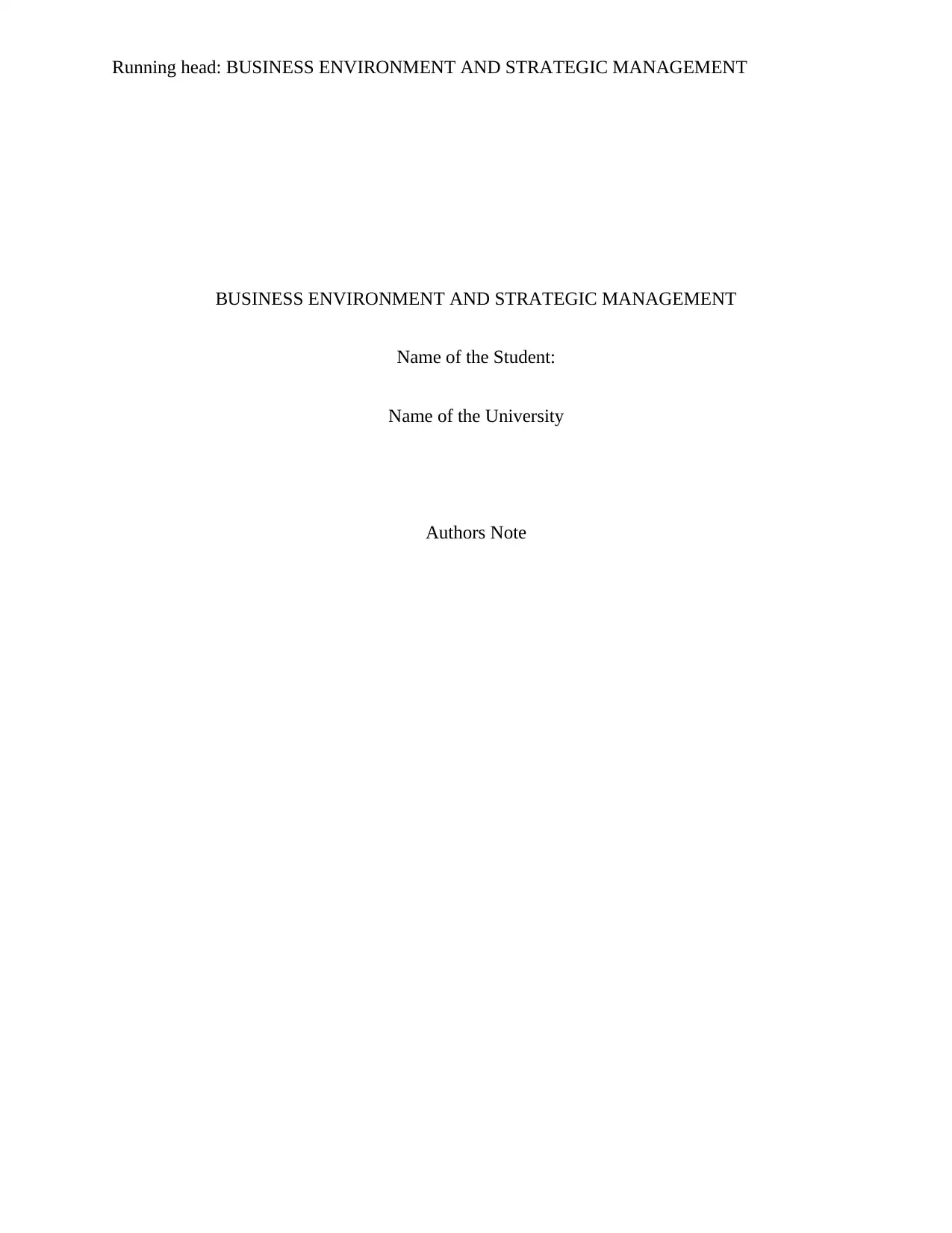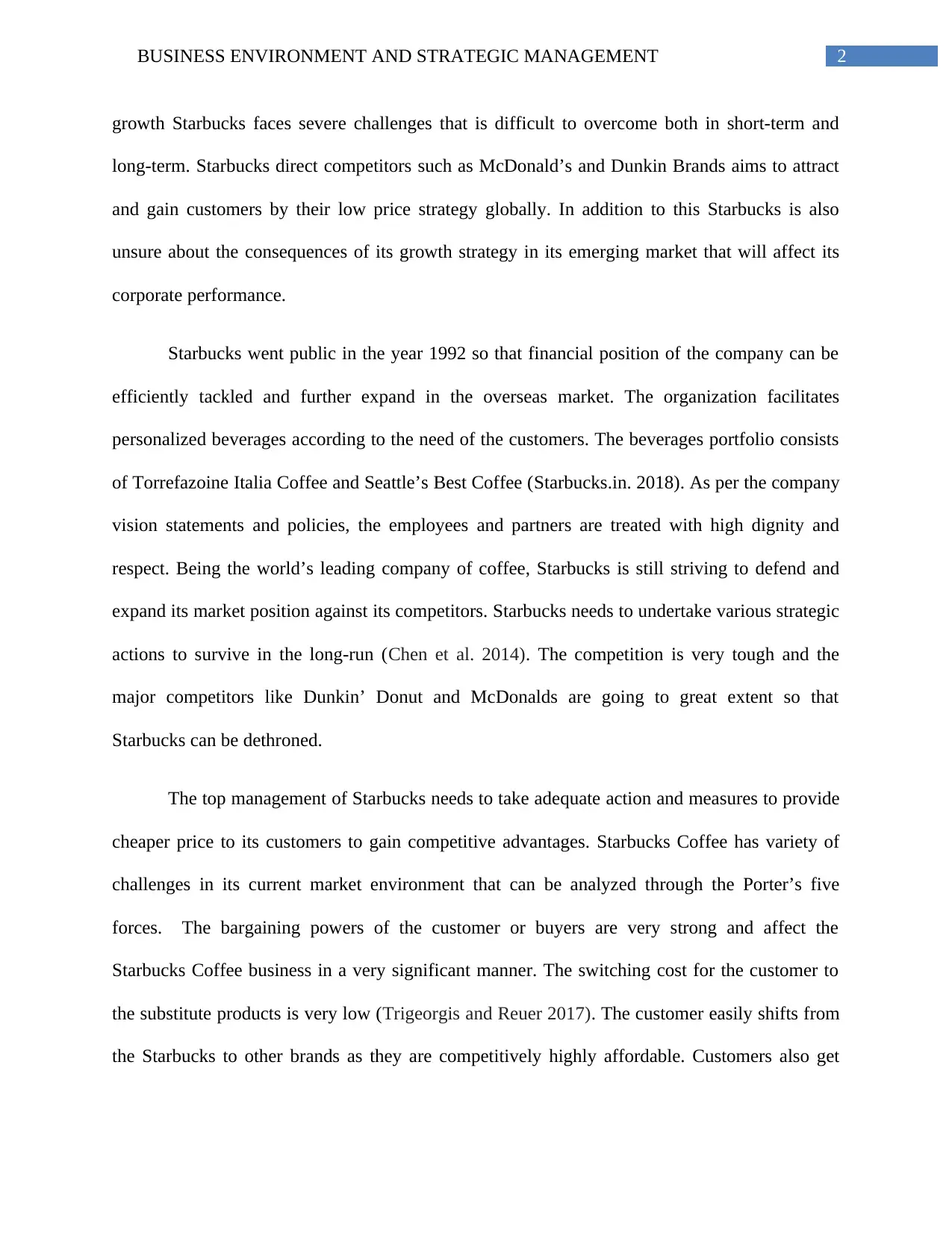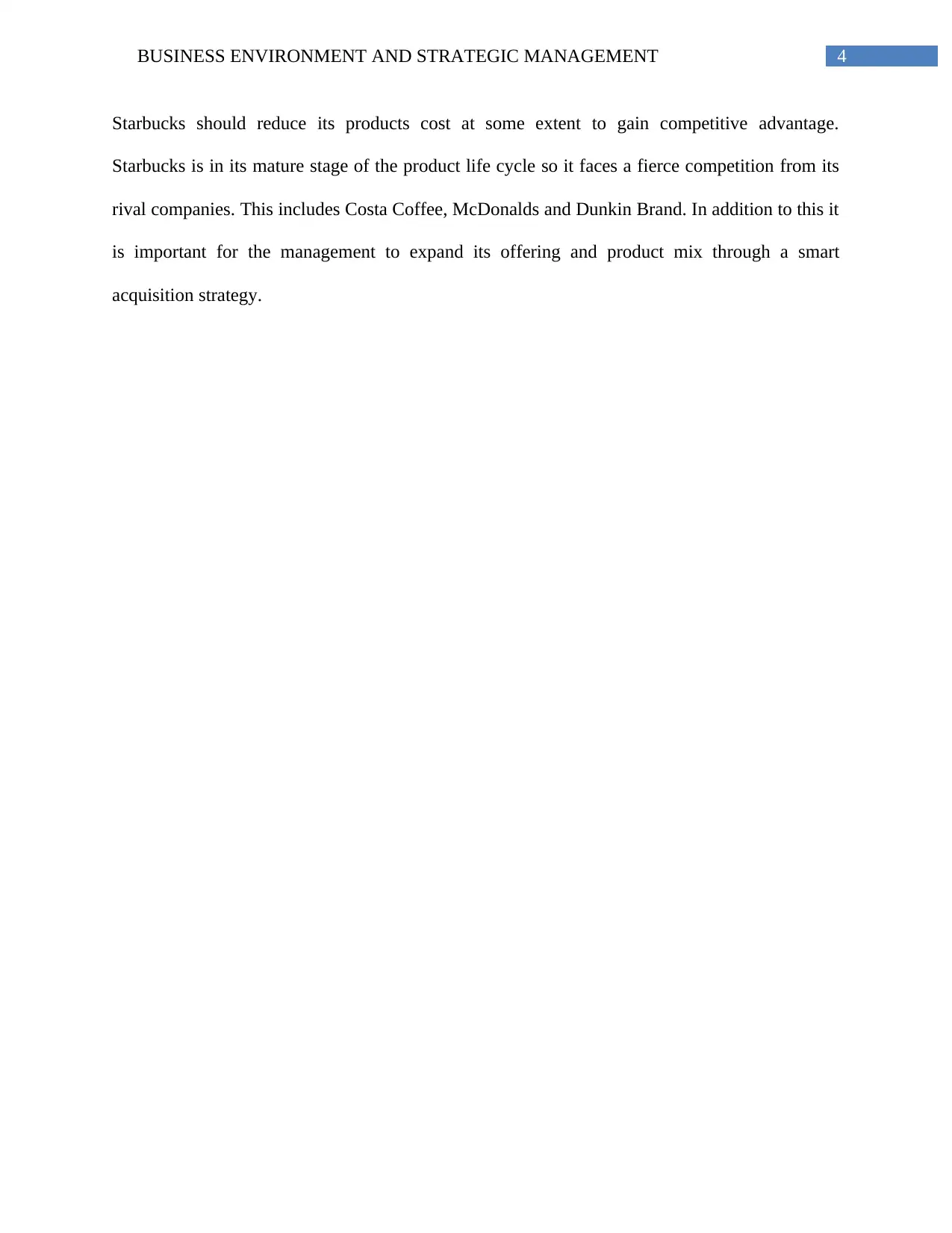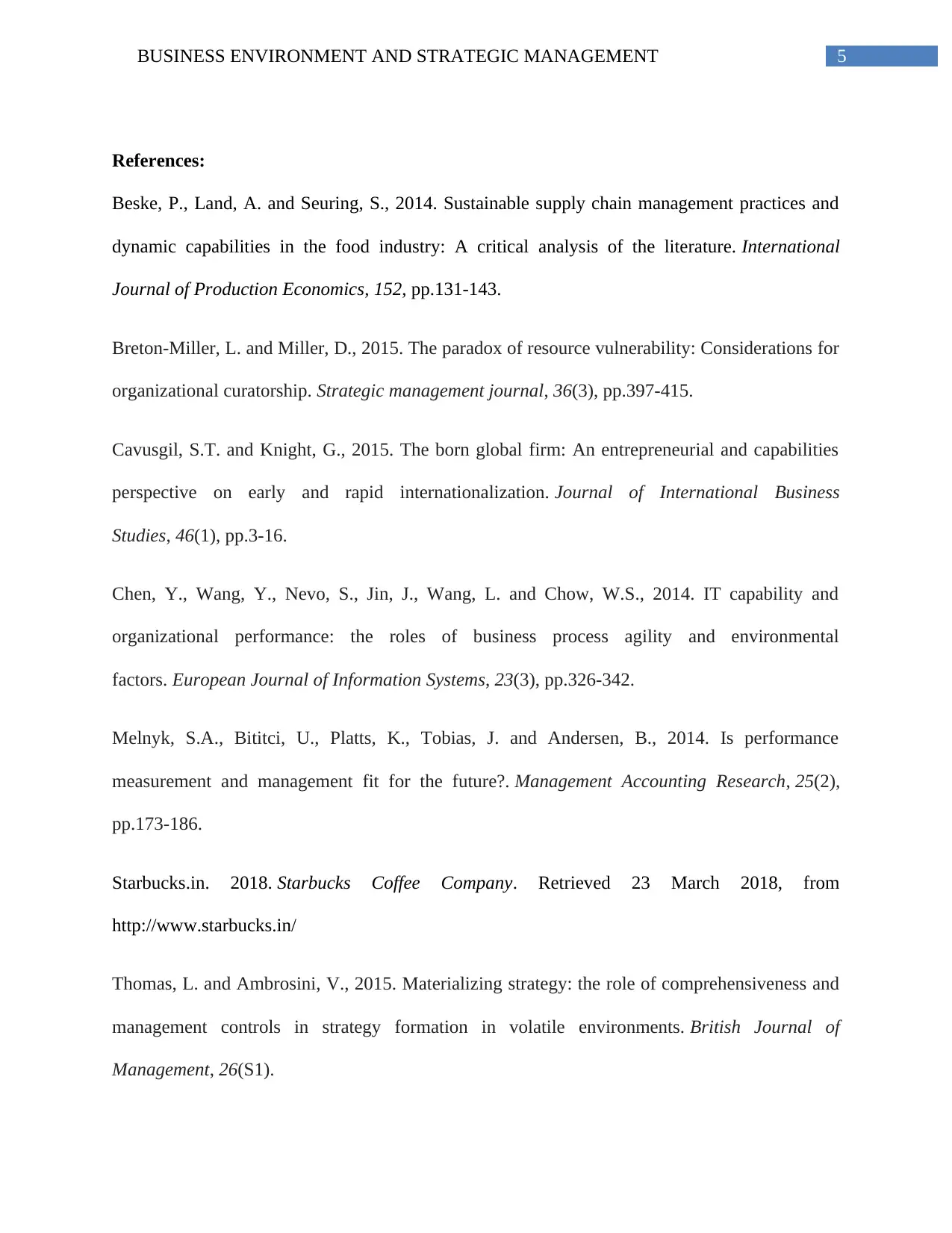Analyzing the Business Environment and Strategy of Starbucks
VerifiedAdded on 2021/04/24
|7
|1396
|121
Report
AI Summary
This report provides an analysis of Starbucks' business environment and strategic management. It begins with an overview of Starbucks' global presence and market position, highlighting its success as a leading coffee retailer. The report then delves into the challenges Starbucks faces, including competition from McDonald's and Dunkin' Brands, price sensitivity of customers, and the impact of low switching costs. It utilizes Porter's five forces framework to analyze the competitive landscape, emphasizing the strong bargaining power of customers. The report also discusses Starbucks' strategies, such as product diversification and the importance of gaining competitive advantages by reducing product costs and expanding product mix. It stresses the need for proactive measures to maintain market position and achieve long-term success in a dynamic and competitive environment. The report concludes by referencing academic sources to support the analysis.

Running head: BUSINESS ENVIRONMENT AND STRATEGIC MANAGEMENT
BUSINESS ENVIRONMENT AND STRATEGIC MANAGEMENT
Name of the Student:
Name of the University
Authors Note
BUSINESS ENVIRONMENT AND STRATEGIC MANAGEMENT
Name of the Student:
Name of the University
Authors Note
Paraphrase This Document
Need a fresh take? Get an instant paraphrase of this document with our AI Paraphraser

1BUSINESS ENVIRONMENT AND STRATEGIC MANAGEMENT
Starbucks is a global organization that deals with the retailing of coffee in the business
environment since the year 1972. The organization has positioned itself as a major seller of high
quality coffee products (Starbucks.in. 2018). Since the last two decades, Starbucks has expanded
its presence and market position to a great extent. In the recent times, the company serves coffee
at more than 64 countries and has also known to become the largest coffee house in the world.
Besides having a positive market outlook, the company is currently facing underestimated
challenges. Starbucks is unable to operate the new segments like its competitors McDonald.
Customers are now more price oriented and as the switching cost is low therefore this makes
them easily to move to more competing brands.
Starbucks primarily operates and competes in the retail coffee and snacks industry. The
industry faced a major slowdown in the economy due to crisis and changing tastes of consumer
which manage the revenue of US decline from 6.6% to $25.9 billion. The consumer therefore
spent less on luxuries and expensive items. The consumer now prefers to cheaper items rather
than coffee and beverages with increased price. The Starbucks industry is growing at a low
annualized growth rate at an average of 0.9% till the year 2013 (Cavusgil and Knight 2015). The
country has revenues currently of $29 US billion that is forecasted to grow over the next five
years at an annualized rate of 3.9%.
Being the largest coffee organization both in terms of market shares and sales has made
Starbucks successful. Due to its high quality coffee products has attracted various customers
throughout the world. In the recent year Starbucks has managed to expand and consolidate its
market position. Despite the undisputed market position in the business environment and high
Starbucks is a global organization that deals with the retailing of coffee in the business
environment since the year 1972. The organization has positioned itself as a major seller of high
quality coffee products (Starbucks.in. 2018). Since the last two decades, Starbucks has expanded
its presence and market position to a great extent. In the recent times, the company serves coffee
at more than 64 countries and has also known to become the largest coffee house in the world.
Besides having a positive market outlook, the company is currently facing underestimated
challenges. Starbucks is unable to operate the new segments like its competitors McDonald.
Customers are now more price oriented and as the switching cost is low therefore this makes
them easily to move to more competing brands.
Starbucks primarily operates and competes in the retail coffee and snacks industry. The
industry faced a major slowdown in the economy due to crisis and changing tastes of consumer
which manage the revenue of US decline from 6.6% to $25.9 billion. The consumer therefore
spent less on luxuries and expensive items. The consumer now prefers to cheaper items rather
than coffee and beverages with increased price. The Starbucks industry is growing at a low
annualized growth rate at an average of 0.9% till the year 2013 (Cavusgil and Knight 2015). The
country has revenues currently of $29 US billion that is forecasted to grow over the next five
years at an annualized rate of 3.9%.
Being the largest coffee organization both in terms of market shares and sales has made
Starbucks successful. Due to its high quality coffee products has attracted various customers
throughout the world. In the recent year Starbucks has managed to expand and consolidate its
market position. Despite the undisputed market position in the business environment and high

2BUSINESS ENVIRONMENT AND STRATEGIC MANAGEMENT
growth Starbucks faces severe challenges that is difficult to overcome both in short-term and
long-term. Starbucks direct competitors such as McDonald’s and Dunkin Brands aims to attract
and gain customers by their low price strategy globally. In addition to this Starbucks is also
unsure about the consequences of its growth strategy in its emerging market that will affect its
corporate performance.
Starbucks went public in the year 1992 so that financial position of the company can be
efficiently tackled and further expand in the overseas market. The organization facilitates
personalized beverages according to the need of the customers. The beverages portfolio consists
of Torrefazoine Italia Coffee and Seattle’s Best Coffee (Starbucks.in. 2018). As per the company
vision statements and policies, the employees and partners are treated with high dignity and
respect. Being the world’s leading company of coffee, Starbucks is still striving to defend and
expand its market position against its competitors. Starbucks needs to undertake various strategic
actions to survive in the long-run (Chen et al. 2014). The competition is very tough and the
major competitors like Dunkin’ Donut and McDonalds are going to great extent so that
Starbucks can be dethroned.
The top management of Starbucks needs to take adequate action and measures to provide
cheaper price to its customers to gain competitive advantages. Starbucks Coffee has variety of
challenges in its current market environment that can be analyzed through the Porter’s five
forces. The bargaining powers of the customer or buyers are very strong and affect the
Starbucks Coffee business in a very significant manner. The switching cost for the customer to
the substitute products is very low (Trigeorgis and Reuer 2017). The customer easily shifts from
the Starbucks to other brands as they are competitively highly affordable. Customers also get
growth Starbucks faces severe challenges that is difficult to overcome both in short-term and
long-term. Starbucks direct competitors such as McDonald’s and Dunkin Brands aims to attract
and gain customers by their low price strategy globally. In addition to this Starbucks is also
unsure about the consequences of its growth strategy in its emerging market that will affect its
corporate performance.
Starbucks went public in the year 1992 so that financial position of the company can be
efficiently tackled and further expand in the overseas market. The organization facilitates
personalized beverages according to the need of the customers. The beverages portfolio consists
of Torrefazoine Italia Coffee and Seattle’s Best Coffee (Starbucks.in. 2018). As per the company
vision statements and policies, the employees and partners are treated with high dignity and
respect. Being the world’s leading company of coffee, Starbucks is still striving to defend and
expand its market position against its competitors. Starbucks needs to undertake various strategic
actions to survive in the long-run (Chen et al. 2014). The competition is very tough and the
major competitors like Dunkin’ Donut and McDonalds are going to great extent so that
Starbucks can be dethroned.
The top management of Starbucks needs to take adequate action and measures to provide
cheaper price to its customers to gain competitive advantages. Starbucks Coffee has variety of
challenges in its current market environment that can be analyzed through the Porter’s five
forces. The bargaining powers of the customer or buyers are very strong and affect the
Starbucks Coffee business in a very significant manner. The switching cost for the customer to
the substitute products is very low (Trigeorgis and Reuer 2017). The customer easily shifts from
the Starbucks to other brands as they are competitively highly affordable. Customers also get
⊘ This is a preview!⊘
Do you want full access?
Subscribe today to unlock all pages.

Trusted by 1+ million students worldwide

3BUSINESS ENVIRONMENT AND STRATEGIC MANAGEMENT
instant beverages and drinks just like Starbucks from restaurant at lower prices. Starbucks should
reduce its price due to high availability of the substitute’s product.
Starbucks customers do not have to spend extra money to shift to the substitute’s product
due to the low switching cost. This affects the target customers of Starbucks due to its high and
increased cost for the products. If the firm’s patron considers the deal with the company highly
expensive or low profitability, they can easily shift to its substitute brands (Beske, Land and
Seuring 2014). The cost of switching brands or coffee shop is minimal as the Starbucks products
are highly expensive. The products are priced at premium in comparison to its competitors. This
has led the coffee business to shift from the developed market to developing market.
The organization top managements need to implement better strategies to gain
competitive advantage and achieve success in the long run. Starbucks economies of scale should
be efficiently utilized so that the cost could be reduced. The organizational performance in the
business environment should be quarterly evaluated to avoid any kind of accumulative losses
(Thomas and Ambrosini 2015). Corrective actions and measures should be taken to overcome
the loss in the long run. Due to the economic downturn in the year 2009, the customer’s does not
want to spend such high prices o beverages and coffee products. Besides coffee and beverages,
Starbucks can venture into product diversification to increase profitability. Extending into
horizontal business line would further help Starbucks to increase its growth in the long-term.
Starbucks top management should ensure proper and effective measures to gain
competitive advantage by prioritizing competitive rivalry and customers bargaining power. One
of the top management concerns is the increase in competition as the organization faces various
competitors with different specialties and strategies. Therefore, it can be concluded that
instant beverages and drinks just like Starbucks from restaurant at lower prices. Starbucks should
reduce its price due to high availability of the substitute’s product.
Starbucks customers do not have to spend extra money to shift to the substitute’s product
due to the low switching cost. This affects the target customers of Starbucks due to its high and
increased cost for the products. If the firm’s patron considers the deal with the company highly
expensive or low profitability, they can easily shift to its substitute brands (Beske, Land and
Seuring 2014). The cost of switching brands or coffee shop is minimal as the Starbucks products
are highly expensive. The products are priced at premium in comparison to its competitors. This
has led the coffee business to shift from the developed market to developing market.
The organization top managements need to implement better strategies to gain
competitive advantage and achieve success in the long run. Starbucks economies of scale should
be efficiently utilized so that the cost could be reduced. The organizational performance in the
business environment should be quarterly evaluated to avoid any kind of accumulative losses
(Thomas and Ambrosini 2015). Corrective actions and measures should be taken to overcome
the loss in the long run. Due to the economic downturn in the year 2009, the customer’s does not
want to spend such high prices o beverages and coffee products. Besides coffee and beverages,
Starbucks can venture into product diversification to increase profitability. Extending into
horizontal business line would further help Starbucks to increase its growth in the long-term.
Starbucks top management should ensure proper and effective measures to gain
competitive advantage by prioritizing competitive rivalry and customers bargaining power. One
of the top management concerns is the increase in competition as the organization faces various
competitors with different specialties and strategies. Therefore, it can be concluded that
Paraphrase This Document
Need a fresh take? Get an instant paraphrase of this document with our AI Paraphraser

4BUSINESS ENVIRONMENT AND STRATEGIC MANAGEMENT
Starbucks should reduce its products cost at some extent to gain competitive advantage.
Starbucks is in its mature stage of the product life cycle so it faces a fierce competition from its
rival companies. This includes Costa Coffee, McDonalds and Dunkin Brand. In addition to this it
is important for the management to expand its offering and product mix through a smart
acquisition strategy.
Starbucks should reduce its products cost at some extent to gain competitive advantage.
Starbucks is in its mature stage of the product life cycle so it faces a fierce competition from its
rival companies. This includes Costa Coffee, McDonalds and Dunkin Brand. In addition to this it
is important for the management to expand its offering and product mix through a smart
acquisition strategy.

5BUSINESS ENVIRONMENT AND STRATEGIC MANAGEMENT
References:
Beske, P., Land, A. and Seuring, S., 2014. Sustainable supply chain management practices and
dynamic capabilities in the food industry: A critical analysis of the literature. International
Journal of Production Economics, 152, pp.131-143.
Breton‐Miller, L. and Miller, D., 2015. The paradox of resource vulnerability: Considerations for
organizational curatorship. Strategic management journal, 36(3), pp.397-415.
Cavusgil, S.T. and Knight, G., 2015. The born global firm: An entrepreneurial and capabilities
perspective on early and rapid internationalization. Journal of International Business
Studies, 46(1), pp.3-16.
Chen, Y., Wang, Y., Nevo, S., Jin, J., Wang, L. and Chow, W.S., 2014. IT capability and
organizational performance: the roles of business process agility and environmental
factors. European Journal of Information Systems, 23(3), pp.326-342.
Melnyk, S.A., Bititci, U., Platts, K., Tobias, J. and Andersen, B., 2014. Is performance
measurement and management fit for the future?. Management Accounting Research, 25(2),
pp.173-186.
Starbucks.in. 2018. Starbucks Coffee Company. Retrieved 23 March 2018, from
http://www.starbucks.in/
Thomas, L. and Ambrosini, V., 2015. Materializing strategy: the role of comprehensiveness and
management controls in strategy formation in volatile environments. British Journal of
Management, 26(S1).
References:
Beske, P., Land, A. and Seuring, S., 2014. Sustainable supply chain management practices and
dynamic capabilities in the food industry: A critical analysis of the literature. International
Journal of Production Economics, 152, pp.131-143.
Breton‐Miller, L. and Miller, D., 2015. The paradox of resource vulnerability: Considerations for
organizational curatorship. Strategic management journal, 36(3), pp.397-415.
Cavusgil, S.T. and Knight, G., 2015. The born global firm: An entrepreneurial and capabilities
perspective on early and rapid internationalization. Journal of International Business
Studies, 46(1), pp.3-16.
Chen, Y., Wang, Y., Nevo, S., Jin, J., Wang, L. and Chow, W.S., 2014. IT capability and
organizational performance: the roles of business process agility and environmental
factors. European Journal of Information Systems, 23(3), pp.326-342.
Melnyk, S.A., Bititci, U., Platts, K., Tobias, J. and Andersen, B., 2014. Is performance
measurement and management fit for the future?. Management Accounting Research, 25(2),
pp.173-186.
Starbucks.in. 2018. Starbucks Coffee Company. Retrieved 23 March 2018, from
http://www.starbucks.in/
Thomas, L. and Ambrosini, V., 2015. Materializing strategy: the role of comprehensiveness and
management controls in strategy formation in volatile environments. British Journal of
Management, 26(S1).
⊘ This is a preview!⊘
Do you want full access?
Subscribe today to unlock all pages.

Trusted by 1+ million students worldwide

6BUSINESS ENVIRONMENT AND STRATEGIC MANAGEMENT
Trigeorgis, L. and Reuer, J.J., 2017. Real options theory in strategic management. Strategic
Management Journal, 38(1), pp.42-63.
Trigeorgis, L. and Reuer, J.J., 2017. Real options theory in strategic management. Strategic
Management Journal, 38(1), pp.42-63.
1 out of 7
Related Documents
Your All-in-One AI-Powered Toolkit for Academic Success.
+13062052269
info@desklib.com
Available 24*7 on WhatsApp / Email
![[object Object]](/_next/static/media/star-bottom.7253800d.svg)
Unlock your academic potential
Copyright © 2020–2025 A2Z Services. All Rights Reserved. Developed and managed by ZUCOL.





